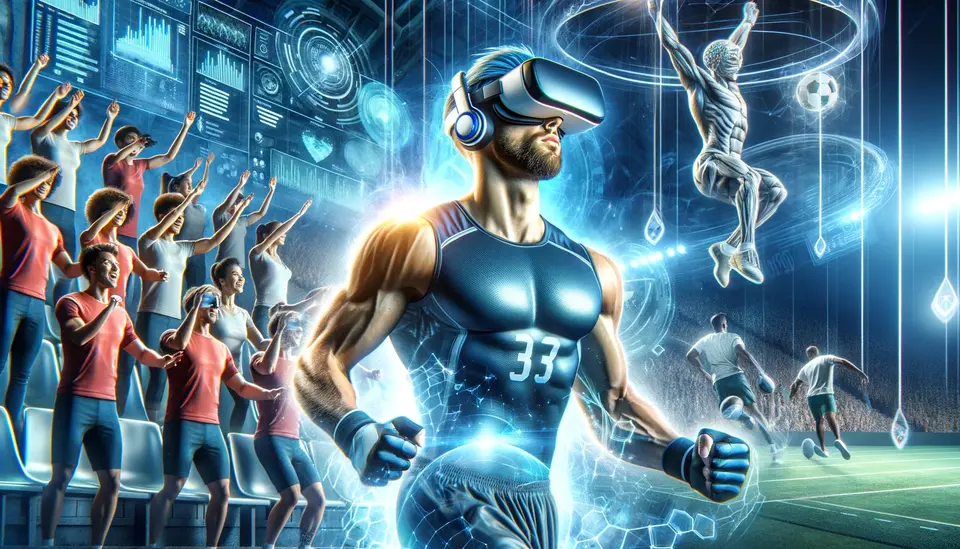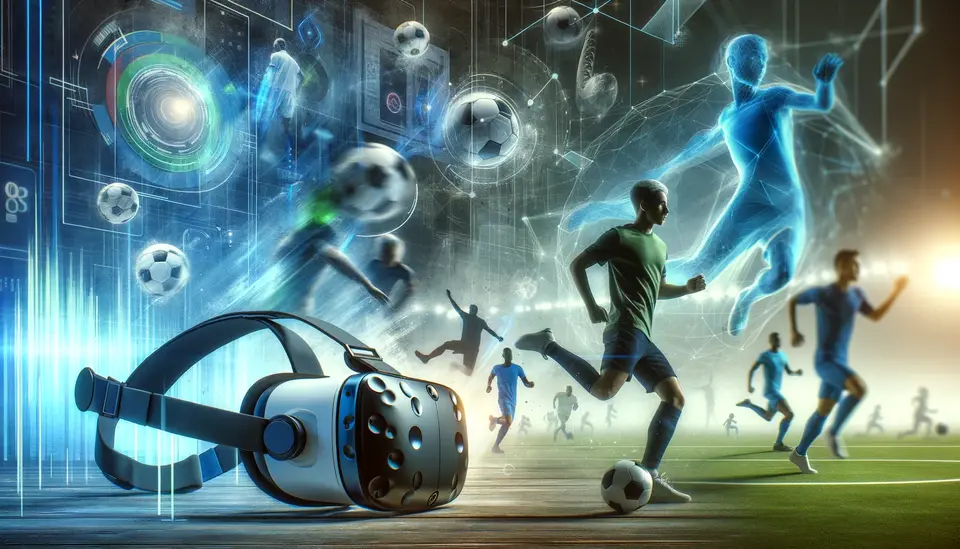Benefits of Virtual Reality for Sports
Posted on May 9, 2024 8 minutes 1524 words
Table of contents
Introduction
In an era marked by rapid technological innovation, Virtual Reality (VR) has emerged as a transformative force across various sectors, sports being one of the most compelling. Originally conceived within the realms of science fiction, VR technology has now transcended its initial novelty to become a critical tool in professional sports training, fan engagement, and injury rehabilitation.
The essence of virtual reality lies in its ability to create simulated environments that mimic the real world or conjure utterly fantastical realms, offering users an immersive sensory experience. By donning a VR headset, individuals can transport themselves to a virtual space where the limitations of the physical world often do not apply. In the context of sports, this means athletes can train, analyze, and experience their sport in ways previously imaginable only in their wildest dreams.
The adoption of VR in sports is driven by its unparalleled ability to combine high levels of realism in training scenarios with complete control over the environment. Athletes can practice their skills against virtual opponents, rehearse complex plays, or expose themselves to high-pressure situations repeatedly and consistently which would be impossible or impractical to recreate in real life. Moreover, the technology is proving to be a game-changer for fans, who can now enjoy immersive viewing experiences that rival the thrill of watching a game live from the stands.
Enhancing Training and Performance
Virtual Reality in Training
The integration of VR into sports training routines is not just an innovation but a revolution. Elite athletes and teams across sports like soccer, basketball, and Formula 1 are increasingly turning to VR to gain a competitive edge. For instance, professional soccer teams use VR to simulate match situations for tactical training and to improve players’ decision-making speed under pressure. These simulated environments allow players to experience game-speed scenarios repeatedly, enhancing their situational awareness without the physical toll of traditional training methods.
One notable example involves a Premier League football club, which implemented a VR training regime to enhance goalkeepers’ reaction times. By simulating penalty kicks in VR, goalkeepers could face hundreds of penalties in a single session, enabling rapid iterative learning without the risk of injury.
Technical Skills Development
Beyond tactical awareness, VR is exceptionally effective in honing technical skills. Sports like cricket and baseball, where millisecond decisions and precision are crucial, benefit immensely from VR training. Batters can face virtual bowlers who deliver pitches at varying speeds and angles, offering endless variability that helps improve hitting accuracy and timing under controlled conditions.
Additionally, VR allows for the simulation of diverse environmental conditions—training in a virtual high-altitude environment or a windy scenario can prepare athletes for competitions that might take place under similar conditions. This level of preparation was previously unachievable without significant logistical efforts and expense.
Psychological Preparation
Perhaps one of the most significant benefits of VR in sports is its capacity to enhance psychological resilience. Athletes can use VR to practice mindfulness and visualization techniques in a serene, distraction-free setting. Moreover, by recreating intense, high-pressure game situations, VR helps athletes build mental toughness and prepare psychologically for crucial moments.
For example, professional skiers might use VR to visualize a downhill race course, experiencing the high speeds and sharp turns in a controlled setting to improve their mental readiness. Similarly, basketball players might simulate free-throw scenarios with a virtual crowd to replicate the pressure of a real game situation.
Injury Prevention and Rehabilitation
Safer Training Environments
Virtual reality offers a unique proposition for sports training—not only does it provide highly realistic simulations, but it does so in a manner that significantly reduces physical risk. VR creates a controlled environment where athletes can practice without the physical wear and tear associated with traditional training methods. This aspect is particularly valuable in contact sports like football or rugby, where the physical intensity of training can lead to injuries even before a game is played.
For example, American football teams are using VR to simulate game situations for quarterbacks, allowing them to read defenses and make split-second decisions without the risk of contact. These sessions help in developing cognitive skills while preserving the athletes’ physical health during practice.
Rehabilitation Uses
Rehabilitation is another area where VR is making a substantial impact. By using virtual scenarios that guide athletes through precise movements, VR helps in restoring mobility and improving coordination after injuries. This high-tech approach can be tailored to the specific recovery needs of an athlete, which enhances the effectiveness of the rehabilitation process.
A notable case is that of a professional basketball player who used VR-based therapy to recover from a knee injury. The VR setup allowed him to simulate walking and running movements, which helped him regain knee strength and functionality faster than traditional rehab methods would have allowed.
Benefits Over Conventional Methods
The benefits of VR in rehabilitation extend beyond just physical recovery. Because VR can simulate an athlete’s presence on the field or court, it helps maintain their mental well-being and keeps their competitive spirit alive during the recovery process. Additionally, VR rehabilitation can be more engaging and motivating compared to traditional methods, which often involve repetitive tasks that can become monotonous.
Fan Engagement and Experience
Virtual Stadiums
Virtual reality is revolutionizing the fan experience by providing immersive experiences that are as close as possible to being at the game without actually being there. Fans can put on a VR headset and find themselves in a virtual stadium watching live games as if they were in the best seats of the house. This technology not only enhances the experience for fans who can’t attend the games physically but also opens up new revenue streams for teams and venues through virtual ticket sales.
An example of this is the VR fan experience offered by the NBA, where fans can choose different camera angles and even sit courtside at a live game, experiencing the action as it happens from the comfort of their homes.
Interactive Content
Beyond live games, VR allows fans to relive historical moments in sports history. Imagine experiencing iconic Olympic moments or famous football plays from the perspective of the athlete involved. This kind of interactive content not only boosts fan engagement but also helps new generations connect with sports history in a dynamic and engaging way.
Sports museums and halls of fame are also beginning to incorporate VR to bring exhibits to life. Fans can experience historical games, learn about players’ lives and careers, and understand the game’s evolution through a completely immersive approach.

Training and Tactical Analysis
Detailed Tactical Adjustments
The use of VR for in-depth tactical preparation and analysis has become a game-changer for coaches and teams across all levels of sports. By enabling a three-dimensional, immersive analysis of gameplay, coaches can dissect complex tactical scenarios and communicate strategies more effectively to their players.
In football, for example, coaches use VR to recreate specific match situations for review and analysis. This allows players to see exactly what their position should be in real-time during a game scenario. They can understand spatial relationships and timing better than traditional video playback would allow, adjusting their tactics based on immersive playback and analysis.
Performance Analysis
VR also offers sophisticated tools for performance analysis. By combining VR with biometric data, coaches can get a detailed understanding of an athlete’s performance under various conditions. This includes reading vital signs like heart rate and energy expenditure in simulated conditions, providing a holistic view of an athlete’s fitness and readiness.
Integration of AI with VR takes this one step further by offering predictive insights that can inform future training and game strategies. For instance, AI can analyze patterns from numerous game scenarios to recommend optimal plays or identify potential weaknesses in an opponent’s strategy.
Future Prospects of VR in Sports
Technological Advancements
As VR technology continues to evolve, the potential for even more realistic and interactive sports training and fan experiences increases. Future advancements may include better sensory feedback (haptic feedback), which can simulate the feeling of different textures and impacts, enhancing the realism of VR simulations.
Another exciting development could be the integration of augmented reality (AR) with VR to provide a seamless blend of real and virtual worlds, offering more comprehensive training aids and enriched fan experiences.
Expanding Accessibility
Looking forward, one of the most important goals for VR in sports is to make this technology more accessible at the grassroots and amateur levels. As equipment costs decrease and the technology becomes more widespread, smaller teams and individual athletes will also be able to benefit from the detailed analysis and enhanced training methods that VR provides.
Conclusion
Throughout this blog post, we have explored various dimensions in which Virtual Reality is transforming the sports industry. From enhancing training and performance to improving injury prevention and rehabilitation, and revolutionizing fan engagement, VR’s impact is profound and far-reaching.
As we look to the future, the continued advancement of VR technology promises even greater enhancements in how sports are played, analyzed, and enjoyed. The potential for VR in sports is limited only by the imagination of those pushing the boundaries of this exciting technology.








